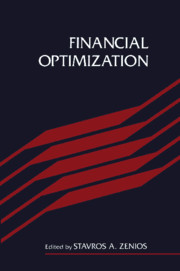Book contents
- Frontmatter
- Contents
- List of contributors
- Foreword
- Preface
- Acknowledgments
- Part I General overview
- Part II Models
- Part III Methodologies
- 10 Incorporating transaction costs in models for asset allocation
- 11 Bond portfolio analysis using integer programming
- 12 Scenario immunization
- 13 Mortgages and Markov chains: a simplified evaluation model
- 14 Parallel Monte Carlo simulation of mortgage-backed securities
- Index
14 - Parallel Monte Carlo simulation of mortgage-backed securities
Published online by Cambridge University Press: 09 February 2010
- Frontmatter
- Contents
- List of contributors
- Foreword
- Preface
- Acknowledgments
- Part I General overview
- Part II Models
- Part III Methodologies
- 10 Incorporating transaction costs in models for asset allocation
- 11 Bond portfolio analysis using integer programming
- 12 Scenario immunization
- 13 Mortgages and Markov chains: a simplified evaluation model
- 14 Parallel Monte Carlo simulation of mortgage-backed securities
- Index
Summary
Introduction
Mortgage-backed securities — MBS for short — have emerged in the 1980s as an important class of securities. The total size of outstanding mortgage debt, the potential for MBS market growth, and the complexity of mortgage securities present unique opportunities and challenges for financial analysts. At the end of 1985 outstanding mortgage debt in the United States was approximately $2.2 trillion, of which nearly 70% was in residential mortgages. This sum dwarfs the more established corporate and government debt markets. To date only some 20% to 30% of the outstanding residential debt has been securitized via the issuance of mortgage-backed securities, but MBS represent the fastest growing segment of the debt markets. Growth in outstanding MBS was dramatic into the mid 1980s — from $3 billion in MBS outstanding in 1979 to $500 billion by the end of 1986. Trading in MBS after issuance has also increased significantly in the last few years — from $243 billion in 1981 to $1.2 trillion in 1985. Interest in MBS is not restricted to the US alone; for example, 90% of all residential debt in Denmark has been securitized.
MBS facilitate the flow of funds from the ultimate lenders in the capital markets to the mortgage borrower.
- Type
- Chapter
- Information
- Financial Optimization , pp. 325 - 343Publisher: Cambridge University PressPrint publication year: 1993
- 8
- Cited by



